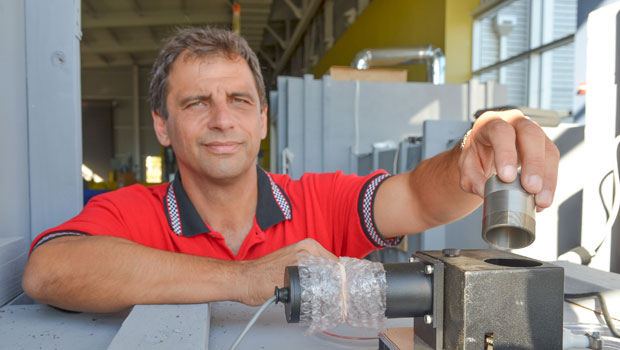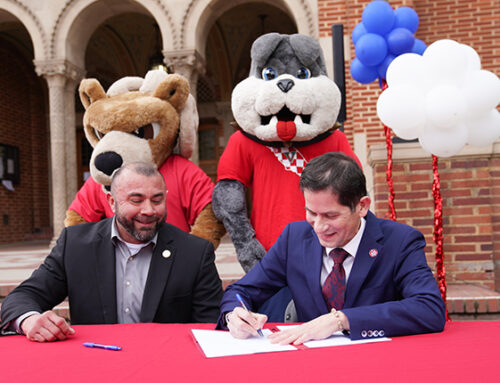A newly-constructed dust tunnel on the Fresno State campus is set to enable research to help improve air quality in the San Joaquin Valley and throughout California.
The tunnel will be used to measure water misting as a means of controlling particulate matter caused by agricultural field operations.
Leading the work is Associate Plant Science Professor Athanasios Alexandrou, with support from staff engineering specialists Diganta Adhikari and Patrick Barnes of Fresno State’s Center for Irrigation Technology.
“The main objective of this project is to investigate the efficacy of a dust plume suppression system in lab conditions,” Alexandrou said.
Dust raised by agricultural operations carries particulate matter, which can be harmful to humans when inhaled. Alexandrou said particulate matter control in the agricultural industry has been a focus of both local and state air pollution control agencies.
Over the past two years the project team has collaborated with a local industry partner to test a modified disk designed to spray a water mist during operation. The problem, from a scientific perspective, was the lack of control in field conditions. “By the time we set up to start the mist and measure the effects, the temperature changes or the wind shifts, changing the whole dynamic of the experiment,” Adhikari said.
To achieve reliable data, the team determined it would have to move into a laboratory setting. With no wind tunnel of appropriate size in Central California, the team contracted with Texas A&M University to use a tunnel on that campus. The testing produced important preliminary data, but the long-distance travel and work became too costly and time-consuming. With the support of area industry partners and funding organizations, the team decided to build its own tunnel on the Fresno State campus.
“The tunnel is based on the Texas A&M tunnel as described in the literature and offers a high degree of automation, which allows the system to start, stop and record each event automatically, avoiding human error,” Alexandrou said. “The design allows the research team to add various devices and to monitor the particulate matter using a variety of instruments.”
One of the goals of the research is to prove that the misting process can effectively reduce particulate matter. This will require extensive testing under a variety of treatments. It will also provide the research team with solid data for use in developing techniques that will mitigate particulate matter not only for agriculture but potentially for other industries that raise or emit particulate matter into the air.
“The interest for the agricultural industry in this work is significant, since the project may provide us with a technique to reduce fugitive particulate matter emissions during disking operations,” Alexandrou said.
The wind tunnel is housed in the large open laboratory area of the International Center for Water Technology at Barstow and Chestnut avenues in Fresno. The tunnel boasts a 40 horsepower, three-phase variable-frequency drive electric motor with a blower capable of generating wind speeds up to 25 miles per hour in a three-by-three foot square tunnel.
“It feels like a cyclone in there at top speed,” Adhikari said.
Final adjustments are being made on the operational electronics of the tunnel, with trials set to begin soon after. Experimental work and data recording will continue over the next year.
Collaborating agencies in the field work is the University of California. Partial funding came from the California State University Agricultural Research Institute.
For more information, contact Alexandrou at aalexandrou@csufresno.edu
Related links:



